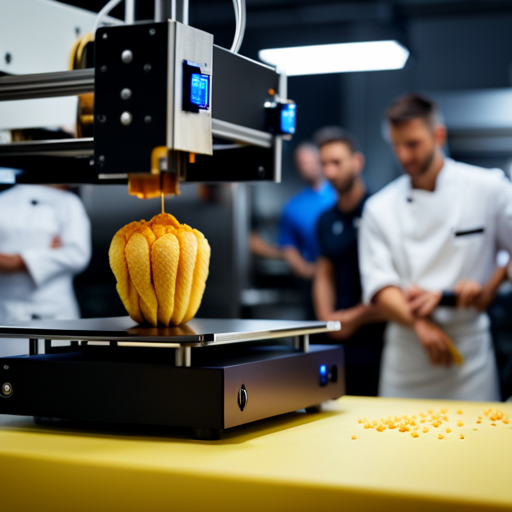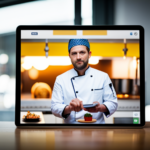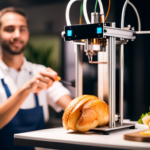In a world where technology continues to revolutionize the way we consume and interact with food, the concept of 3D printing has emerged as a game-changer.
This article delves into the strategic process of developing a unique selling proposition for food 3D printing. By combining innovation with consumer needs and sustainability, we aim to evoke a shift in the culinary landscape.
Join us as we explore the key elements that will shape the future of food production and consumption.
Understanding the Market Landscape
Understanding the market landscape involves thoroughly analyzing the current demand, competition, and trends in the food 3D printing industry.
Market trends in the food 3D printing industry are influenced by various factors including technological advancements, consumer behavior, and the regulatory environment. As 3D food printing becomes more mainstream, market trends indicate a growing consumer demand for personalized and sustainable food options.
Consumer behavior also plays a crucial role in shaping the market landscape. There is an increasing preference for healthy, customizable, and visually appealing food products, which is driving the adoption of 3D food printing technology. Additionally, the rise of e-commerce and on-demand food delivery services has created new opportunities for 3D printed food products to reach a wider audience.
Understanding these market trends and consumer behavior is essential for businesses operating in the food 3D printing industry to develop a unique selling proposition that resonates with the evolving needs and preferences of their target audience.
Identifying Target Audience Needs
Analyzing the market landscape provides valuable insights into the needs and preferences of the target audience for food 3D printing, guiding businesses in identifying the specific requirements and desires that drive consumer engagement and purchasing decisions.
Understanding preferences: It is crucial to comprehend the dietary restrictions, flavor profiles, and nutritional priorities of the target audience. This includes catering to diverse dietary needs such as gluten-free, dairy-free, vegan, and other specific dietary requirements.
Meeting demands: Identifying the demand for customization, convenience, and sustainability in food choices is essential. This involves recognizing the need for personalized nutrition, on-the-go meal solutions, and environmentally conscious food options.
Embracing innovation: Recognizing the audience’s openness to embracing novel food experiences and innovative culinary creations through 3D printing technology is pivotal. This includes exploring unique textures, shapes, and food designs that captivate consumer interest and curiosity.
Leveraging Technology Advancements
As food 3D printing evolves, it offers the potential to revolutionize culinary experiences by introducing innovative ways to create and present food.
Leveraging technology advancements in this field can lead to enhanced food customization, allowing for tailored nutrition, unique textures, and personalized flavors.
These advancements open up possibilities for chefs and food manufacturers to push the boundaries of traditional food preparation and presentation.
Innovating Culinary Experiences
Leveraging technology advancements, the culinary industry is undergoing innovative changes through the integration of food 3D printing. This integration is revolutionizing culinary creativity and enhancing the sensory experience for both chefs and diners.
The following advancements illustrate the transformative impact of food 3D printing:
-
Personalized Dining Experiences: Food 3D printing allows chefs to create customized dishes tailored to individual preferences, dietary restrictions, and nutritional needs, offering a personalized and unique dining experience.
-
Novel Texture and Flavor Combinations: By leveraging 3D printing technology, chefs can experiment with intricate designs, textures, and flavor combinations that were previously difficult to achieve, expanding the possibilities for culinary creativity and sensory exploration.
-
Sustainable Food Production: 3D printing enables the creation of sustainable and eco-friendly food options, addressing environmental concerns while offering innovative culinary experiences.
Enhancing Food Customization
Enhancing food customization through the utilization of technology advancements is a pivotal aspect of food 3D printing’s evolution. The integration of 3D printing technology allows for the creation of personalized flavors, catering to individual preferences and dietary requirements.
Moreover, it enables the elevation of gourmet presentation, offering intricate and visually stunning food designs that were previously unattainable through traditional methods. Through the precision and intricacy of 3D printing, chefs and food manufacturers can explore new ways to customize and present their culinary creations, offering a truly unique and tailored experience for consumers.
This level of customization not only enhances the overall dining experience but also opens doors to new market segments and consumer preferences. The utilization of technology in food 3D printing is revolutionizing the way we perceive and experience food, showcasing the limitless possibilities for customization and personalization.
Showcasing Customization and Personalization
With the ability to offer limitless customization options, food 3D printing provides a unique opportunity to cater to individual tastes and dietary preferences. This level of personalization opens up a world of possibilities for both consumers and businesses in the food industry.
Here are three ways in which food 3D printing showcases customization and personalization:
-
Tailored Nutritional Content: Food 3D printing allows for precise control over the composition of ingredients, making it possible to tailor the nutritional content of each dish to meet specific dietary requirements or health goals.
-
Unique Shapes and Designs: From intricately designed confectionery to personalized pasta shapes, 3D food printing enables the creation of visually stunning and unique food products that can be tailored to suit individual preferences or themed events.
-
Flavor Customization: With the ability to layer different ingredients and flavors with precision, food 3D printing offers the opportunity to create personalized culinary experiences, allowing individuals to customize the taste and texture of their food according to their preferences.
Emphasizing Sustainability and Health Benefits
Building upon the customization and personalization capabilities of food 3D printing, the technology also allows for the emphasis on sustainability and health benefits. Food 3D printing enables the use of sustainable packaging and nutrient-rich ingredients, aligning with the growing consumer demand for eco-friendly and health-conscious options. The table below illustrates some key aspects of emphasizing sustainability and health benefits in food 3D printing:
| Emphasizing Sustainability and Health Benefits | |
|---|---|
| Sustainable Packaging | Using biodegradable and eco-friendly materials for packaging. |
| Nutrient Rich Ingredients | Incorporating natural and healthy components to enhance the nutritional value of printed food. |
| Reduced Food Waste | Precision in ingredient usage minimizes food waste, supporting sustainability. |
| Health-Driven Customization | Tailoring food prints to meet specific dietary needs and preferences. |
| Eco-Friendly Practices | Implementing energy-efficient processes and reducing carbon footprint in production. |
Crafting Compelling Brand Story and Identity
In establishing a compelling brand story and identity for food 3D printing, it is imperative to align the narrative with the emphasis on sustainability and health benefits already highlighted in the previous discussion.
This brand storytelling should revolve around the innovative and sustainable nature of 3D printed food, highlighting its positive impact on the environment and the health-conscious choices it offers to consumers.
Additionally, the visual identity of the brand should reflect these values, using earthy and natural tones to convey sustainability, and incorporating images of fresh, organic ingredients to emphasize health and quality.
The brand story should also integrate the technological aspect of 3D printing, showcasing the precision and customization it offers in creating nutritious and visually appealing food products.
Furthermore, it is crucial to weave in the human element, conveying the passion and expertise of the culinary and technological experts behind the food 3D printing process, thus fostering trust and credibility with the audience.
Frequently Asked Questions
How Can Food 3D Printing Help to Reduce Food Waste in the Restaurant Industry?
Reducing food waste in the restaurant industry can be achieved through sustainable solutions like food 3D printing. This innovative technology allows for precise portion control, customizing food shapes, and utilizing alternative ingredients, thus minimizing waste and promoting sustainability.
What Are the Potential Legal and Regulatory Challenges That Could Impact the Adoption of Food 3D Printing Technology?
Navigating the legal implications and regulatory challenges surrounding food 3D printing technology is crucial. Potential issues such as intellectual property rights, food safety regulations, and labeling requirements must be carefully addressed to ensure the successful adoption of this innovative technology.
What Are Some Unique Ways That Food 3D Printing Can Be Used to Cater to Individuals With Dietary Restrictions or Allergies?
Customized diets and personalized menus are key benefits of food 3D printing for individuals with dietary restrictions or allergies. This technology enables tailored food production, accommodating specific nutritional needs and allergen-free options.
How Can Food 3D Printing Be Integrated Into Existing Supply Chains and Distribution Networks?
Integrating food 3D printing into existing supply chains and distribution networks presents challenges such as adapting to diverse food materials and ensuring regulatory compliance. However, this innovation offers benefits like reduced waste and personalized nutrition.
What Are the Potential Environmental Benefits of Using Food 3D Printing Technology in the Food Industry?
Food 3D printing technology offers potential environmental benefits such as reducing food waste, using sustainable ingredients, and optimizing production processes. These practices align with sustainable goals and can contribute to a more eco-friendly food industry.
Conclusion
In the vast garden of food innovation, the unique selling proposition for 3D printed food is akin to a rare and exquisite flower. By understanding the market landscape, identifying target audience needs, and leveraging technological advancements, the bloom of success can be nurtured.
Just as a gardener tends to their plants, so too must food 3D printing developers nurture their unique selling proposition to thrive in the market. This includes showcasing customization and personalization, emphasizing sustainability and health benefits, and crafting a compelling brand story and identity.
By focusing on these key areas, 3D printed food developers can cultivate a strong market presence and stand out from the competition. The ability to create customized and personalized food products offers a unique value proposition that appeals to consumers seeking bespoke dining experiences. Additionally, highlighting the sustainability and health benefits of 3D printed food can attract environmentally conscious and health-conscious individuals.
Furthermore, embracing technological advancements is crucial for staying ahead in the rapidly evolving food industry. By keeping up with the latest developments in 3D printing technology and incorporating them into their processes, developers can continuously improve the quality and efficiency of their products.
Crafting a compelling brand story and identity is also essential for establishing a strong market position. By effectively communicating the vision, mission, and values behind their 3D printed food offerings, developers can create an emotional connection with their target audience and foster brand loyalty.
In conclusion, the success of 3D printed food lies in nurturing its unique selling proposition through market understanding, technological advancements, customization, sustainability, and a compelling brand story. With careful cultivation and strategic planning, the potential for growth and success in this innovative field is abundant.


